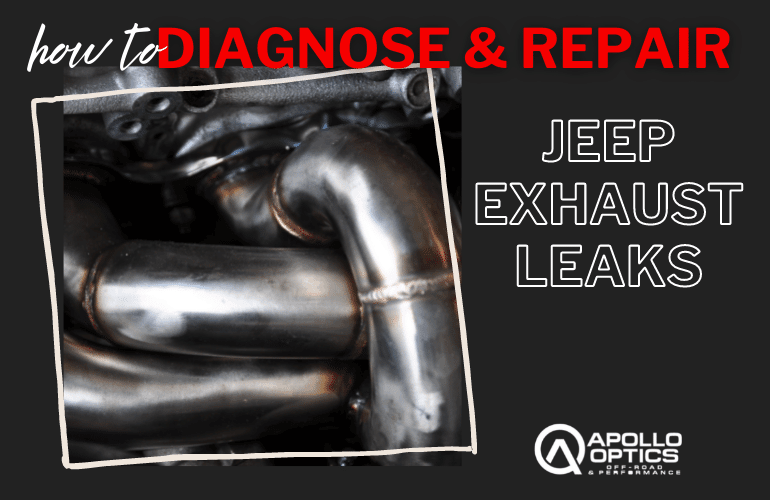 Exhaust
leaks are a common complaint among vehicle owners the world over, including
those behind the wheel of a Jeep. While no vehicle is immune to exhaust leaks,
Jeeps of varying models tend to be especially prone to this problem, with most
experiencing a leak in one form or fashion at some point during their service
life.
Exhaust
leaks are a common complaint among vehicle owners the world over, including
those behind the wheel of a Jeep. While no vehicle is immune to exhaust leaks,
Jeeps of varying models tend to be especially prone to this problem, with most
experiencing a leak in one form or fashion at some point during their service
life.
From early AMC-era CJ Jeeps to modern Fiat-Chrysler Jeep Wrangler JK Rubicons, occasional exhaust leaks seem to run hand-in-hand with Jeep ownership. Even Jeep Grand Cherokees and standard Cherokees see their share of exhaust-related issues.
Luckily, exhaust leaks are often easy to diagnose and relatively straightforward to repair. Those with a little knowledge and a bit of mechanical aptitude can typically remedy such a problem and have their Jeep back on the road in rapid succession.
The following guide will supply you with the necessary information to conduct your own exhaust system diagnosis and make necessary repairs when the need arises.
What Is an Exhaust Leak?
When a vehicle’s engine is in operation and combustion is taking place, exhaust gases are formed in the process. These hot exhaust gases are expelled through open exhaust valves located in the cylinder head at the top of each combustion chamber. As exhaust gases pass through the cylinder head, they are purged through exhaust ports that correspond with each cylinder.
Upon exiting the head, exhaust gases pass through a vehicle’s exhaust manifold(s), inline catalytic converters, intermediate exhaust pipe, muffler, and tailpipe. This process continues on an infinite basis, as long as a vehicle’s engine is in operation.
An exhaust leak is defined as any departure of exhaust gases from a vehicle’s exhaust system, other than through the normal route of expulsion, by way of the system’s tailpipe.
Is an Exhaust Leak Worth Worrying About?
The short yet definitive answer to this quandary is a resounding yes. Not only can an exhaust leak negatively impact vehicle operation, but it can also be extremely hazardous to one’s health. One byproduct of the combustion process is carbon monoxide, which is contained within exhaust gas.
Carbon monoxide is poisonous, and when inhaled in large quantities, can lead to carbon monoxide poisoning. Symptoms of carbon monoxide poisoning include, but are not limited to, headache, dizziness, weakness, upset stomach, vomiting, chest pain, and confusion. In severe cases, carbon monoxide poisoning can even be fatal.
While exhaust leaks located toward the rear of a vehicle are highly unlikely to expose a driver to much in the way of carbon monoxide, those found in the vicinity of a vehicle’s cabin are another story altogether. In any event, an exhaust leak should be remedied at the first available opportunity.
Symptoms of an Exhaust Leak
Exhaust leaks are often discovered in one of two ways: by sense or by the onset of operational efficiency-related issues. In a number of cases, an exhaust leak becomes evident to a driver when the smell of raw exhaust grows rather pronounced. On the other hand, the illumination of a check engine light can key a driver in on an irregularity within their vehicle’s exhaust system.
The following are some of the most common symptoms associated with an exhaust leak.
- Strong Exhaust Smell
- Check Engine Light
- Poor Fuel Economy
- Rumbling or Ticking Noise
Diagnosing an Exhaust Leak
In many cases, diagnosing the root cause of a Jeep’s exhaust leak can be more difficult than actually making any necessary repairs. Much of this difficulty stems from the fact that a vehicle’s exhaust system is rather sizable, leaving many places for a leak to present itself.
The following steps can be followed in order to isolate the root cause of your Jeep’s annoying exhaust leak.
Note: Be cautious when working in or around hot exhaust components. At operational temperatures, a vehicle’s exhaust system builds up a substantial amount of heat, which can lead to severe burns if touched with bare hands or arms. It is advisable to wear thermal sleeves or gloves when working around the hot exhaust. Alternatively, wait for your vehicle’s exhaust to cool before restarting the engine and proceeding with diagnostic efforts.
Check for The Presence Of Diagnostic Codes
If you suspect that your Jeep is experiencing an exhaust leak, check for the presence of any active or stored trouble codes before proceeding in your diagnostic efforts. This can be done with the aid of an OBD2 scan tool. Alternatively, most retail parts stores will pull diagnostic codes for a customer, free of charge.
In many cases, an exhaust leak will cause a lean condition to be detected by a vehicle’s oxygen sensors, thereby setting a check engine light. This stems from the fact that air can be introduced through an exhaust leak if it is substantial enough in size. The presence of such a code can assist you in keying in on whether the source of your leak is upstream or downstream of a vehicle’s O2 sensors.
Perform A Visual Inspection
The next order of business is to perform a thorough visual inspection of your vehicle’s exhaust system, paying close attention to each individual component. If an exhaust leak is audible, start your vehicle before your inspection, while attempting to isolate the location of any irregular exhaust sounds. Start at your Jeep’s exhaust manifold, looking for any cracks or broken manifold bolts. Carefully feel your way around the manifold’s junction with the cylinder head in the vicinity of the exhaust manifold gasket.
If no leaks are found, continue moving rearward, thoroughly inspecting all piping as well as any components such as catalytic converters, resonators, and mufflers. As you run your hand over each respective area, listen for a change in the sound associated with a leak, which could potentially reveal its source. In some cases, it might be necessary to remove corresponding heat shields for ease of access, especially in areas adjacent to the driveshaft.
Use Soapy Water on Cold Exhaust
If manual inspection of your Jeep’s exhaust system does not yield the results that you were hoping for, soapy water and a spray bottle can be used as an additional means of tracking down hard to find leaks. In order to employ this method, your exhaust will need to be cool to the touch, as hot exhaust will cause any water which is applied to evaporate in seconds.
Simply start your vehicle’s engine and begin spaying any suspect areas throughout the vehicle’s exhaust system, slowly working from the front of the vehicle rearward. As exhaust gases escape from trouble areas, the soapy water which has been applied will begin to bubble, thereby confirming a leak's location.
Smoke It Out:
If you still have been unable to locate the source of your exhaust leak, smoke can be used to achieve desired results. Many exhaust shops and dealerships have smoke machines which they use to find tricky exhaust or vacuum leaks. If you can gain access to such a unit, finding even the slightest of exhaust leaks can be a breeze.
With your engine off and your exhaust cool, you can tape off your Jeep’s exhaust tip, remove an O2 sensor, and stick the smoke machine’s nozzle into the resulting hole. After letting the machine run for approximately one minute, the sources of your leak should become evident, as the synthetic smoke produced by the machine begins to disperse through the first available outlet.
If a smoke machine cannot be procured for use, a dose of Seafoam can be run through your Jeep’s intake system by way of the vacuum line located at the brake booster. When cycled through a running engine, this specialty cleaner typically causes a noticeable amount of smoke to be dispersed from a vehicle’s tailpipe. As this occurs, inspect your Jeep’s entire exhaust system for signs of escaping smoke in the same manner as would be the case when using a smoke machine.
Repairing an Exhaust Leak
Once the sources of an exhaust leak has been determined, an adequate repair must be made. In the bulk of cases, this will necessitate the replacement of any part which has failed. For example, if a cracked manifold is found to be the source of your troubles, a new manifold should be installed. Likewise, if a damaged muffler, resonator, or catalytic convertor is discovered, replacement is also advised.
In some cases, the repair of an exhaust leak will require the use of a welder. This is often the case when a particular component, such as a muffler, is to be installed, and it is not slip-fit or clampable in nature. This is also typically the case when installing sections of the exhaust pipe or when attempting to patch small holes. If you have a welder and are proficient in its use, repairs can quickly and efficiently be rendered from home. However, if you do not have access to a welder, a trip to your local qualified muffler shop is likely in store.
Note: When working on any part of your exhaust system, the use of a quality penetrant is indispensable. Exhaust bolts and studs are renowned for being difficult to loosen, which inevitably leads to fastener damage. To save time, energy, effort, and money, spray all fasteners with penetrating oil the day before work is set to begin if at all possible. This provides time for the penetrating oil to permeate any rust, thereby making the job ahead much easier in the long run.
Additionally, it is imperative to always follow any applicable torque specs when tightening exhaust-related fasteners. These specs can be found in factory service manuals or through a quick google search of specification documents.
Mastery Over Exhaust Leaks
Although aggravating to the core, exhaust leaks of any degree rarely ever pose any risk of irrevocable damage to your Jeep. However, it is essential to understand the role that a properly functioning exhaust system plays in your Jeep’s day to day functionality. By referencing the above-listed steps, you will be able to quickly and efficiently track down the source of any exhaust leaks which you might encounter and make all necessary repairs in record time. This gets you out of the shop and on the trails, where you can get back to what matters most, enjoying the Jeep lifestyle.

